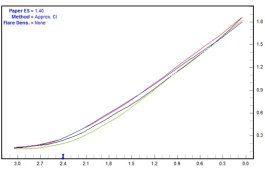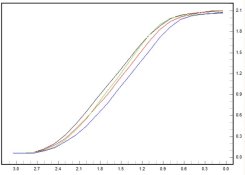sanking
Member
Some weeks ago I announced that Kirk Keyes, Tom Hoskinson and I would be doing a study of staining versus non-staining developers. We are convinced that such a study should be useful because there is so much confusion, myths and uncertainties out there about this subject.
It took a while to get the study started but finally after gathering materials I began my initial part of the study, which deals primarily with the use of sensitometry with these two types of developers. As some of you know, my opinion is that negatives developed in staining developers will print on graded sliver papers with the same, or very similar, reproduction of tonal values, as negatives developed in non-staining developers, if the two types of negatives are developed to the same effective CI. This assumes of course that the readings by densitometer will be done in a Mode or with a cut-off filter than closely approximates the spectral sensitivity of the paper. For graded papers this sensitivity is in the blue band of wavelength.
At this point I have carried out extensive testing with two different staining developers and four different films, two traditional emulsions and two T-grain emulsions. As a result of these tests I am able to state as an absolute fact about which there should be no discussion that graded silver will print the same with staining and non-staining developers when both are developed to the same effective CI.
As clear evidence of this fact I am attaching two sets of curves. One is a family of curves using the same film but four different developers, two staining and two non-staining. The time of development was such that a close range of negative CI was obtained, ranging from .63 to .65, specifically as follows. The CI for all of the negatives, whether developed in a staining or non-staining developer, was determined by reading with a densitometer using a broad band blue aperture, and the plots were made using Phil Davis' Winplotter program.
Blue Curve .63
Red Curve .65
Black Curve .66
Green curve .67.
The other is a set of paper curves made on Ilford Galerie FB #2 paper from the four negatives. If you look carefully at the curves you will see that they are virtually identical, the only difference being a slight difference in contrast that results from the range of negative CI from .63 to .67.
Since this is an on-going project I wont identify the film and developers here, but it will all be included in the study, together with results from the other three films, which I will state here for the record show the same kind of result.
The next step is to try to make some sense out of the use of staining developers with VC papers.
Sandy
It took a while to get the study started but finally after gathering materials I began my initial part of the study, which deals primarily with the use of sensitometry with these two types of developers. As some of you know, my opinion is that negatives developed in staining developers will print on graded sliver papers with the same, or very similar, reproduction of tonal values, as negatives developed in non-staining developers, if the two types of negatives are developed to the same effective CI. This assumes of course that the readings by densitometer will be done in a Mode or with a cut-off filter than closely approximates the spectral sensitivity of the paper. For graded papers this sensitivity is in the blue band of wavelength.
At this point I have carried out extensive testing with two different staining developers and four different films, two traditional emulsions and two T-grain emulsions. As a result of these tests I am able to state as an absolute fact about which there should be no discussion that graded silver will print the same with staining and non-staining developers when both are developed to the same effective CI.
As clear evidence of this fact I am attaching two sets of curves. One is a family of curves using the same film but four different developers, two staining and two non-staining. The time of development was such that a close range of negative CI was obtained, ranging from .63 to .65, specifically as follows. The CI for all of the negatives, whether developed in a staining or non-staining developer, was determined by reading with a densitometer using a broad band blue aperture, and the plots were made using Phil Davis' Winplotter program.
Blue Curve .63
Red Curve .65
Black Curve .66
Green curve .67.
The other is a set of paper curves made on Ilford Galerie FB #2 paper from the four negatives. If you look carefully at the curves you will see that they are virtually identical, the only difference being a slight difference in contrast that results from the range of negative CI from .63 to .67.
Since this is an on-going project I wont identify the film and developers here, but it will all be included in the study, together with results from the other three films, which I will state here for the record show the same kind of result.
The next step is to try to make some sense out of the use of staining developers with VC papers.
Sandy
Attachments
Last edited by a moderator:












